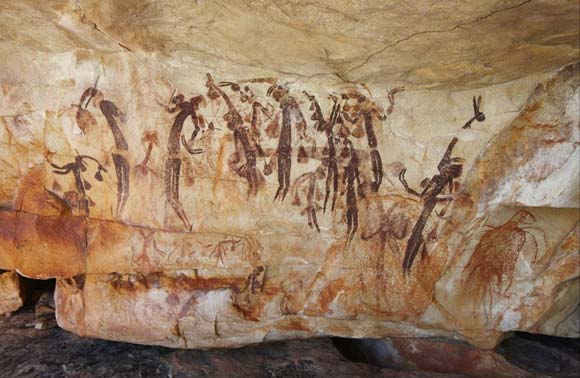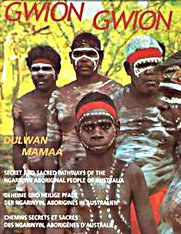Arts
Bradshaw (Gwion Gwion) rock art
Bradshaw (Gwion Gwion) paintings could provide answers to archaeology's big questions.They are very old, yet beautifully painted. Most of them are well hidden in the Kimberley.

Wishing you knew more about Aboriginal culture? Search no more.
Get key foundational knowledge about Aboriginal culture in a fun and engaging way.
This is no ordinary resource: It includes a fictional story, quizzes, crosswords and even a treasure hunt.
Stop feeling bad about not knowing. Make it fun to know better.

What is Bradshaw (Gwion Gwion) rock art?
Bradshaw, or Gwion rock art, are sophisticated paintings dotted across approximately 100,000 sites spread over an area of 50,000 square kilometres [1] (about the size of Costa Rica in Central America, or Slovakia in Europe). They are thought to be at least 17,000, perhaps more than 25,000 years old. (Compare this to the famed Egyptian hieroglyphs which are a mere 5,000 years old.)
Today the Ngarinyin people of the Kimberley are the custodians of this art form.[2]
The ancient Bradshaw rock paintings are very different to any other Aboriginal rock art found in Australia. They depict graceful human figures engaged in display or hunt. Figures are beautifully painted, adorned with tassels, hair ornaments and even clothing. The compositions finely balanced.
Some of the paintings are small, others up to 5 metres long and 3 metres high.
At first glimpse, the Gwions appear different from the Wandjina rock art which is a more abstract style painted in the past 3,500 years and directly related to living Aboriginal culture.
One might think himself viewing the painted walls of an Egyptian temple.
— Joseph Bradshaw [3]
Gwion mysteries
Nobody yet knows how or why the Gwions suddenly began. Art usually evolves and becomes more complex over time, yet the Gwions did not. "What is intriguing about the Gwion Gwion is that the first iteration of the art is the most sophisticated and beautifully painted, which suggests that whoever did the art was portraying a developed culture," finds Maria Myers, Chair of the Kimberley Foundation Australia. [1]
Maybe artists had changed materials from impermanent to permanent surfaces?
At the height of the Last Glacial Maximum, 18,000 to 20,000 years ago, conditions became so harsh and arid that the majority of the population left the Kimberley, which was largely abandoned for the next 8,000 to 10,000 years.
For now, no-one knows their exact age, as the lack of organic matter in the paintings ruled out radiocarbon dating. [1]
The Gwion artists disappeared, leaving their magnificent paintings, but barely another trace of their existence. Gwion rock art ceased, as suddenly as it had begun.
Gwion paintings can be divided into 4 eras:
- "Tassel” era. This is the earliest era. Paintings depict happy days. Slender men and women are adorned with multi-strand tassels swinging from waist- bands, armlets, anklets, chest-plates, bangles; all topped with headdresses featuring pompoms and plumes.
- “Sash” era. Tassels are replaced with three-point sashes flaring from waistbands. Both tassel and sash Gwion figures frequently seem in ceremonial mode and float in a trance-like state.
- "Elegant action” figures. This era marks an abrupt change. Stripped of all adornments, bar headdresses, people are portrayed running, leaping, busily gathering with dillybags, hunting kangaroos. Society has become more vigilant in order to survive, as the climate grows colder and aridity increases.
- “Clothes peg” figures. The once celebratory sash and tassel figures are now transformed into linear soldier-like clothes-peg figures, practical bodies hunting with bundles of spears, armed with spear throwers and boomerangs. Aggressive groups are shown in battle, presumably fighting over rapidly diminishing resources and last vestiges of favourable territory.
Revealing some of the secrets
No one knows who painted the Gwions. Aboriginal elders of the Kimberley are very cautious with sharing knowledge and say the paintings are "a secret to protect" [4] or that they know nothing about Bradshaw paintings; they were done by “different people to us”. [3]
But that changed in 1992 when senior Ngarinyin law men decided to reveal and document evidence of the origins of their culture so they could secure native title rights for their land. The Pathway Project documented how the first society and "oldest continuous cultural network in the world" was recorded by Gwion Gwion rock art. [5]
The Elders revealed how Gwion Gwion rock art and Wunan law of blood and land are inseparable, and still alive at the heart of Ngarinyin culture. The Gwion Gwion artworks document and perpetuate this law and serve as "established legal documents" [5] creating separate legal districts. They inform and communicate legal, familial and environmental responsibilities.
At the Australian Rock Art Association (AURA) conference in 1998 one of the Ngarinyin Elders, Paddy Nyawarra, revealed that Gwion Gwion was the title of one of three groups of ancient Kimberley artists: [6]
- Gwion Gwion were artists who invented hunting technology and painting techniques;
- Munga.nyunga were artists who were visionaries of legal concepts and social structures; and
- Jenagi Jenagi were artists as messengers who imported and exported sacred objects along exchange routes (pathways).
Gwion is also a reference to the legendary Gwion Gwion bird, a long-beaked bird that pecks at rock faces to catch insects which sometimes caused their beaks to bleed. The blood trickled down the rock to create the images. [7]
However, as with most Aboriginal art, they often hide many layers of knowledge. "It will take us years to record enough graphic evidence and translate all the meanings related to the significant elements in [just] this one painting", concedes Jeff Doring, who recorded the Elders during the Pathways Project. [8] Understanding country is key to understanding the rock art.
Where can I find Gwion Gwion art?
Gwion paintings lie deliberately hidden in inaccessible rock shelters in the vast Kimberley in Western Australia. They extend across an arc of the north Kimberley, around the Roe River.
Due to the remoteness of the 420,000-square kilometre Kimberley, and the hidden locations, the art was left largely undisturbed, not researched and unrecorded. No-one knows how many paintings there are and if all of them will ever be found.
Experts estimate there are hundreds of thousands of Gwion paintings.
In 1977, Grahame Walsh, from Queensland, began a 30-year campaign to comb the Kimberley for Bradshaw rock art. He photographed, sketched and documented his extensive lay field research, identified some 300 recurring motifs in the paintings and sought to unlock a code to interpret meanings.
Why is this Aboriginal rock art so important?
Gwion rock art across the Kimberley may help find answers to big questions in world archaeology, such as
- critical debates on the timing, route and pace that modern humans dispersed out of Africa,
- if people travelled via Asia and Indonesia to reach Australia,
- how earlier people responded to major changes in climate,
- how often these people moved to and from neighbouring countries.
A major hurdle in understanding the Gwions is the lack of accurate dates. To date a Gwion painting using radiocarbon dating, the paint needs to contain organic material, such as animal fat, plant material or blood, but no such samples have yet been found.
The Bradshaws let Grahame Walsh propose a controversial hypothesis: instead of Australia being continuously settled for 50,000 to 55,000 years by ancestors of contemporary Aboriginal people, Walsh suggested that waves of populations arrived. And one of these waves could have been people from a different ethnic identity, who created the Bradshaws.
It hit me how little is known about Australia’s history before 1788.
— Maria Myers, admirer of Walsh's work [3]
Watch a short video showing a few of the Bradshaw rock art paintings found by Dean and Margaret Graetz in Emma Gorge on El Questro Station in Western Australia:
Who is Bradshaw?
Gwion art written history only begins in 1891, when Melbournian pastoralist Joseph Bradshaw became the first European to discover this stylish rock art after exploring land he had been granted in the Kimberley. The art later became popularly known as the Bradshaws.
Grahame Walsh wrote a book, Bradshaw Art of the Kimberley, which was published in 2000 and is now so rare that a copy on auction costs thousands of dollars. [9]
Grahame Walsh died in 2007, aged 62.
Learn more about Bradshaw (Gwion) paintings

The Bradshaw Foundation Australia has a lot of information about the Bradshaw paintings, explaining in detail the different eras. Their website also has a large photo gallery.
The Book Gwion Gwion Dulwan Mamaa: Secret and Sacred Pathways of the Ngarinyin Aboriginal people of Australia is out of print, but you can try to find it on eBay or used copies on Amazon.